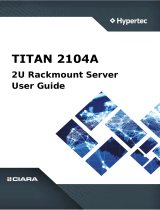- 8 -
3-12-4 MLAN/NCSI Signal .................................................................................................42
3-12-5 Motherboard to 2.5" HDD Backplane Board ...........................................................43
3-12-6 SATA Connections between HDD Backplane Board and Daughter Board .............43
Chapter 4 Motherboard Components ...........................................................................45
4-1 Motherboard Components ............................................................................. 45
4-2 Jumper Settings ............................................................................................ 46
Chapter 5 BIOS Setup ..................................................................................................47
5-1 The Main Menu .............................................................................................. 49
5-2 Advanced Menu ............................................................................................. 52
5-2-1 iSCSI Conguration ................................................................................................53
5-2-2 Intel(R) Virtual RAID on CPU .................................................................................54
5-2-3 Intel(R) I350 Gigabit Network Connection ..............................................................55
5-2-4 VLAN Conguration ................................................................................................57
5-2-5 Intel(R) Omni-Path HFI 100 Series .........................................................................60
5-2-6 Intel(R) Ethernet Controller X550 ...........................................................................62
5-2-7 LSI SAS3 MPT Controller SAS3008 .......................................................................64
5-2-8 Trusted Computing .................................................................................................65
5-2-9 Serial Port Console Redirection .............................................................................66
5-2-10 SIO Conguration ...................................................................................................69
5-2-11 PCI Subsystem Settings .........................................................................................70
5-2-12 Network Stack Conguration ..................................................................................72
5-2-13 Post Report Conguration ......................................................................................73
5-2-14 NVMe Conguration ...............................................................................................74
5-2-15 USB Conguration ..................................................................................................75
5-2-16 Chipset Conguration .............................................................................................76
5-3 Chipset Setup Menu ....................................................................................... 77
5-3-1 Processor Conguration .........................................................................................78
5-3-2 Common RefCode Conguration ...........................................................................80
5-3-3 UPI Conguration ...................................................................................................81
5-3-4 Memory Conguration ............................................................................................82
5-3-5 IIO Conguration ....................................................................................................84
5-3-6 Advanced Power Management Conguration ........................................................86
5-3-7 PCH Conguration .................................................................................................89
5-3-8 Miscellaneous Conguration ..................................................................................91
5-3-9 Server ME Conguration ........................................................................................92
5-3-10 Runtime Error Logging ...........................................................................................93
5-3-11 Power Policy ...........................................................................................................95
5-4 Server Management Menu ............................................................................. 97
5-4-1 System Event Log ..................................................................................................99
5-4-2 View FRU Information ..........................................................................................100





















